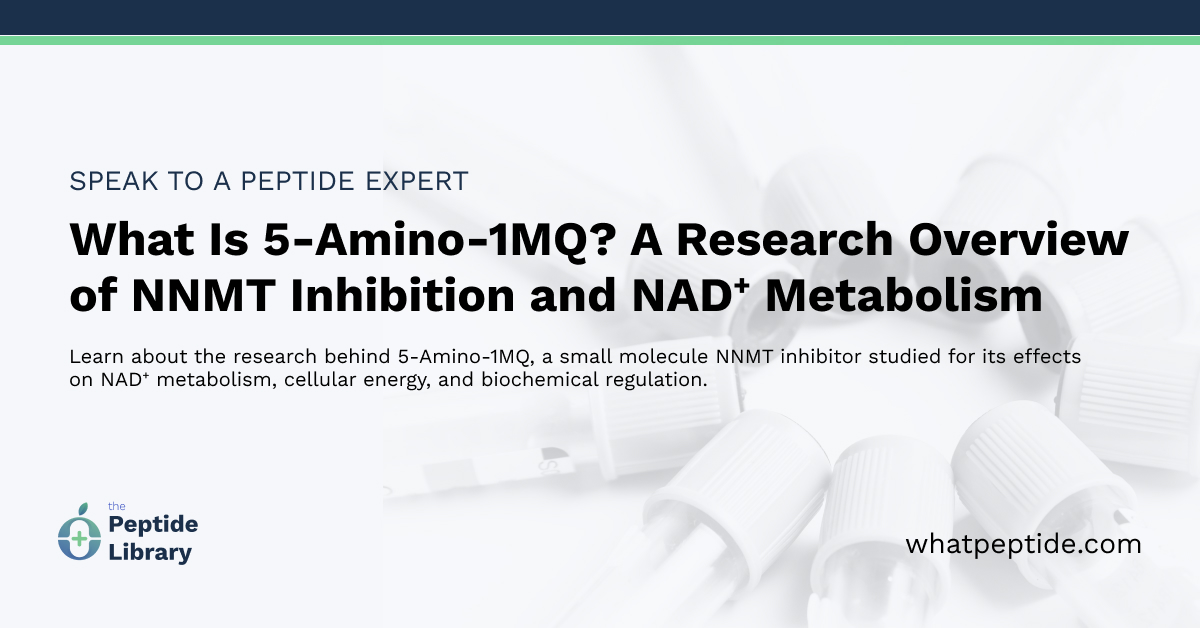Introduction
5-Amino-1MQ (5-amino-1-methylquinolinium) is a synthetic small molecule of growing scientific interest for its role as a nicotinamide N-methyltransferase (NNMT) inhibitor. NNMT is a cytosolic enzyme that catalyzes the methylation of nicotinamide (NAM), a key substrate in the NAD⁺ salvage pathway.
By inhibiting NNMT activity, 5-Amino-1MQ has been explored in laboratory models for its ability to modulate NAD⁺ metabolism, S-adenosylmethionine (SAM) utilization, and methylation flux. These pathways are critical for cellular redox balance, mitochondrial efficiency, and overall metabolic homeostasis.
This article provides a research-focused overview of 5-Amino-1MQ — its structure, biochemical mechanism, and relevance in NNMT-related studies — based solely on publicly available data from resources such as PubChem, NCBI, and UniProt.
Understanding NNMT and Its Biological Role
Nicotinamide N-methyltransferase (NNMT) is an enzyme responsible for catalyzing the methylation of nicotinamide to form 1-methylnicotinamide (1-MNA), using S-adenosylmethionine (SAM) as a methyl donor. This process links two critical metabolic pathways: the NAD⁺ salvage cycle and the one-carbon methylation cycle.
In normal physiological conditions, NNMT regulates nicotinamide clearance and influences intracellular NAD⁺ availability. However, research has shown that excessive NNMT activity may disrupt methyl donor balance and lower NAD⁺ pools, influencing energy metabolism and oxidative stress responses (Kraus et al., 2018).
Mechanism of Action: How 5-Amino-1MQ Inhibits NNMT
5-Amino-1MQ is classified as a selective small molecule NNMT inhibitor. In biochemical studies, it has been observed to bind to the NNMT enzyme’s active site, competitively inhibiting the transfer of a methyl group from SAM to nicotinamide (PubChem Record).
The proposed molecular mechanism involves structural mimicry of nicotinamide, allowing 5-Amino-1MQ to occupy the NNMT substrate-binding pocket. This prevents formation of 1-MNA and may preserve cellular SAM and NAD⁺ levels — effects studied exclusively under controlled in-vitro and preclinical conditions (Ulanovskaya et al., 2013).
Through NNMT inhibition, 5-Amino-1MQ has been investigated for its potential to influence:
- Intracellular NAD⁺/NADH ratios and redox balance
- SAM-dependent methylation reactions
- Cellular energy flux and mitochondrial function
Chemical Structure and Properties
According to PubChem, 5-Amino-1MQ has the molecular formula C11H11N2+ and is typically represented as a methylquinolinium derivative. It appears as a cationic aromatic heterocycle containing a quinoline ring substituted with both a methyl and amino group.
Key identifiers:
- PubChem CID: 16320822
- Synonyms: 5-Amino-1-methylquinolinium, NNMT inhibitor 5-Amino-1MQ
- InChI Key: GCSWYYHTZKPRBJ-UHFFFAOYSA-N
- SMILES: C[N+]1=CC=CC2=C1C=CC(=C2)N
Its cationic nature allows interaction with negatively charged residues within NNMT’s catalytic pocket, which contributes to its inhibitory specificity. Structural analogs are being explored in computational docking studies for improved NNMT selectivity and stability (RCSB Protein Data Bank).
Research on 5-Amino-1MQ and NAD⁺ Metabolism
Several research teams have investigated the role of NNMT inhibition in metabolic regulation and NAD⁺ homeostasis. 5-Amino-1MQ has emerged as a reference compound for probing these mechanisms in experimental models. In vitro data suggest that NNMT suppression can increase intracellular NAD⁺ synthesis by reducing nicotinamide methylation and enhancing substrate availability for the NAMPT pathway.
In one notable preclinical study (Kraus et al., 2018), NNMT inhibition was associated with modulation of adipocyte metabolism and altered methylation profiles in energy-demanding tissues. These findings are significant for basic research but are not intended to suggest clinical or therapeutic applications.
Additional studies have explored NNMT as a regulatory node connecting NAD⁺ salvage to methyl donor availability. Alterations in NNMT expression have been reported in tissues undergoing oxidative or metabolic stress (Pissios, 2017).
Laboratory Handling and Storage Considerations
While specific laboratory protocols vary by institution, general chemical handling standards for synthetic small molecules such as 5-Amino-1MQ are outlined by the OSHA Laboratory Standard (29 CFR 1910.1450) and chemical suppliers like Thermo Fisher.
Common best practices in peptide and small-molecule research include:
- Storing dry material in a desiccated environment at -20°C
- Avoiding repeated freeze–thaw cycles
- Dissolving compounds in sterile solvents or buffers immediately before use
- Handling within fume hoods or glove boxes to avoid contamination
These protocols help maintain compound stability, purity, and reproducibility for research experiments. Always follow institutional safety data sheet (SDS) guidance for specific compounds.
Summary
5-Amino-1MQ is a valuable research compound for studying the biochemical and metabolic roles of NNMT in cellular systems. Through selective NNMT inhibition, it allows scientists to investigate how methylation flux and NAD⁺ metabolism interact to influence energy regulation, redox homeostasis, and biosynthetic pathways.
As a synthetic NNMT inhibitor, 5-Amino-1MQ provides insight into one of the emerging intersections of epigenetic methylation and metabolic signaling. Continued research in this field will further clarify the enzyme’s relevance in biochemical and physiological contexts.
References
- PubChem Compound Record: 5-Amino-1MQ
- UniProt: Nicotinamide N-Methyltransferase (NNMT)
- Ulanovskaya O.A. et al. (2013) “NNMT promotes epigenetic remodeling in cancer.” Cell Chemical Biology.
- Kraus D. et al. (2018) “Nicotinamide N-methyltransferase regulates energy metabolism via methylation flux.” Nature Medicine.
- Pissios P. (2017) “NNMT: A metabolic regulator linking methylation and energy metabolism.” Trends in Endocrinology & Metabolism.
- OSHA Laboratory Safety Standard (29 CFR 1910.1450)
All information provided by The Peptide Library is for educational and research purposes only. These compounds are not intended for human consumption or therapeutic use.


Leave a Reply